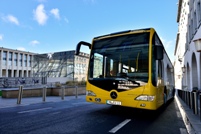
Europe’s four-year project to evaluate innovative public transport systems comes to a conclusion
BELGIUM Following the conclusion of the European Bus System of the Future (EBSF) project, which included four years of work, involving 48 partners, seven demonstration projects and a total budget of around Euro 26 million the UITP (designated as lead coordinator) presented the final case studies on October 15 in Brussels.
EBSF was the biggest roadrelated transportation project funded by the European Commission to date. As a comprehensive, widely networked research project for the design and development of an innovative, high-quality European bus system of the future, four years ago the EBSF project took on the goal of demonstrating the capabilities of a new generation of urban bus networks and creating the basis for an integrated systems approach (vehicle, infrastructure, technology, operation) taking future passenger requirements into account. Project members in seven European countries painstakingly assessed and compiled data from the demonstration projects.
EBSF innovations in IT systems, vehicle design, driver cabins and bus stations were evaluated in real operational scenarios in eight European cities: Bremerhaven, Brunoy, Budapest, Gothenburg, Madrid, Paris, Rome and Rouen, achieving the following key results:
- IT standard architecture: sharing data through open architecture makes buses more connected, improving efficiency and reducing costs. Creates the possibility for operators across Europe to access the same information with large cost savings
- Capacity and Modularity: new modular internal and external bus layout increasing passenger capacity and adapted to demand
- Passenger flow: breakthrough design speeding up boarding and reducing dwell time
- Dynamic passenger information: real-time multimodal information to help passengers make better travel decisions
- Accessibility for all users: seamless interaction between the bus and the platform
- Driver comfort: ergonomically optimised and adjustable driver workspace for improved driver comfort
- Remote diagnostic: new tele-diagnostic system to optimise preventive and predictive maintenance
- Interoperable Automatic Vehicle Monitoring Systems (AVMS): coordinating and managing services across all transport modes, operators and emergency services from an integrated Public Transport Management Centre
- Energy Management: strategies for the management of onboard energy to efficiently reduce consumptions of auxiliaries, also through the use of special material
- EBSF Roadmap for ERTRAC (European Road Transport Research Advisory Council): recommendations for operators and authorities to implement the innovations and priorities for future bus system research developed by more than 100 stakeholders.
“The sheer scale and ambition of EBSF make it unique in the bus sector and even the whole public transport domain and has been a great success on many different levels,” explained UITP Secretary General, Alain Flausch. “Bringing together so many manufacturers and industry partners led to the creation of a variety of innovative solutions and an overall strengthening of the competitive position of European bus manufacturers”.
“The EBSF project has provided a real boost for European research and development in urban bus networks,” added EBSF Project Director, Umberto Guida. “The project results enable the setting up of a framework for harmonisation and standardisation of the EBSF solutions. Indeed, the results are so promising we are confident a sound foundation has been laid to take bus systems forward, enabling them to regain a firm presence in our urban environments”.
Then, led by UITP, the Intelligent, Innovative, Integrated Bus System project (3iBS) is the natural continuation of EBSF, to continue striving for the increased performance, accessibility and efficency of urban bus systems. By capitalising on the results of EBSF, enriched by input from other successful experiences, 3iBS is committed to stimulate research, exploit bus-system innovations, support deployment and implementation of key solutions, and promote exchanges of knowledge about bus systems on an international scale.
Commenting on the project, EvoBus said the partners were looking to create a trailblazing, combinable vehicle, infrastructure and operational designs, as well as possibilities for technical harmonisation and standardisation. In addition to the commitment from EvoBus, MAN, Volvo and Irisbus/ Iveco also provided their visions of the future of local public transport, and ultimately brought them to life by building demonstrator vehicles. Plenty of good ideas – and the EBSF project management is certain about this – will soon be adopted by suppliers and manufacturers, and also incorporated into their development and production processes. Other approaches to solutions, on the other hand, while proving impressive in theory, actually failed when implemented in practice. In some cases such ideas failed due to small technical details, but also due to regulatory circumstances. Yet in fact such “problems” also gave rise to new areas of activity. The EBSF project has shown how effectively and innovatively manufacturers, suppliers and operators can work together when they think and act in a networked way. In view of this, the future of public local transport is likely to be based on a joint effort.


